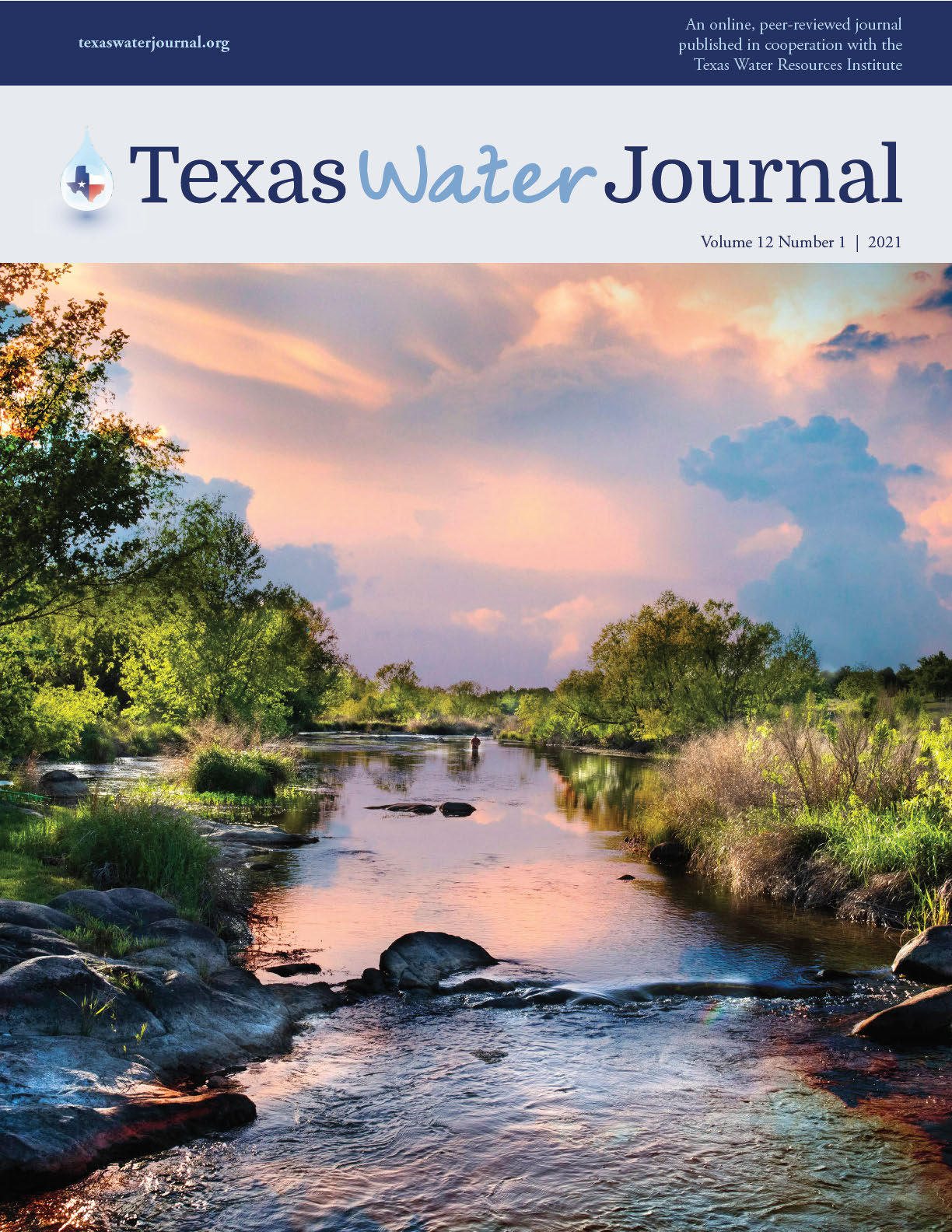Abstract
Seadrift is located on the Texas Gulf Coast with a population of 1,364 people as of the 2010 U.S. Census. In 2012, the city started operation of a $610,878 wind turbine, dedicated to its wastewater treatment plant. The city hoped to save $25,500 yearly using wind energy to displace some of the plant’s electrical demand. The plant’s average load is 0.05 million gallons per day, requiring 236,000 kWh (8.05*108 BTU) yearly. The paper details how Seadrift used manufacturer curves to predict turbine energy production, and how preliminary geotechnical, economic, and environmental analyses help design renewable energy projects. From 2012 to 2015, Seadrift saved $15,928 per year, with yearly wind energy production of 155,738 kWh (5.31*108 BTU) and net present value of $211,493. This study shows how government agencies and rural communities can collaborate to find economically viable solutions to water-energy nexus challenges in Texas and beyond.
Citation: Mbarga AHA, Rainwater K, Song L, Theodore C, Williams WR. 2021. Economic Analyses of the Seadrift Wind-Aided Wastewater Treatment Plant Operations. Texas Water Journal. 12(1):42-57. Available from: https://doi.org/10.21423/twj.v12i1.7096.
References
Ackermann T, Söder L. 2002. An overview of wind energy-status 2002. Renewable and Sustainable Energy Reviews. 6(1):67-127. Available from: https://doi.org/10.1016/ S1364-0321(02)00008-4.
Ben Ali I, Turki M, Belhadj J, Roboam X. 2012. Energy management of a reverse osmosis desalination process powered by renewable energy sources. In: IEEE, editors. Mediterranean Electrotechnical Conference (MELECON). Proceedings of the 16th IEEE MELECON; March 2012; Yasmine Hammamet, Tunisia. Piscataway (New Jersey): Institute of Electrical and Electronics Engineers. p. 800-805. Available from: https://doi.org/10.1109/49.619.
Bodík I, Kubaská, M. 2013. Energy and sustainability of operation of a wastewater treatment plant. Environment Protection Engineering. 39(2):15-24. Available from: https:// www.doi.org/10.37190/EPE130202.
[EPA] Environmental Protection Agency. 2020. Echo: Effluent Charts, City of Seadrift WWTP. Available from: https:// echo.epa.gov/effluent-charts#TX0026671.
[FERC] Federal Energy Regulatory Commission. 2021a. What is a qualifying facility? Available from: https://www.ferc. gov/qf.
[FERC] Federal Energy Regulatory Commission. 2021b. Regional transmission organizations (RTO)/independent system operators (ISO). Available from: https://www. ferc.gov/industries-data/market-assessments/electric-power-markets.
García-Rodríguez L. 2003. Renewable energy applications in desalination: state of the art. Solar Energy. 75(5):381- 93. Available from: https://doi.org/10.1016/j.solener.2003.08.005.
Gude VG, Nirmalakhandan N, Deng S. 2010. Renewable and sustainable approaches for desalination. Renewable and Sustainable Energy Reviews. 14(9):2641-54.
Hamilton SD, Millstein D, Bolinger M, Wiser R, Jeong S. 2020. How does wind project performance change with age in the United States?. Joule. 4(5):1004-1020. Available from: https://doi.org/10.1016/j.joule.2020.04.005.
Kalogirou SA. 2005. Seawater desalination using renewable energy sources. Progress in Energy and Combustion Science. 31(3):242-81. Available from: https://doi. org/10.1016/j.pecs.2005.03.001.
Karagiannis IC, Soldatos PG. 2008. Water desalination cost literature: review and assessment. Desalination. 223(1– 3):448-56. Available from: https://doi.org/10.1016/j. desal.2007.02.071.
Kershman SA, Rheinländer J, Neumann T, Goebel O. 2005. Hybrid wind/PV and conventional power for desalination in Libya–GECOL's facility for medium and small-scale research at Ras Ejder. Desalination. 183(1):1-2. Available from: https://doi.org/10.1016/j.desal.2005.04.021.
Lilienthal P, Lambert P, Lambert T. 2011. Getting Started Guide for HOMER Legacy (Version 2.68). National Renewable Energy Laboratory. Available from: http://www.ecowrex. org/system/files/repository/homergettingstarted268.pdf.
López-Ramírez JA, Lee E, Castañeda RJ, Cho J, García-Vaquero Marín N. 2013. Sustainable improvement of drinking water quality by nanofiltration powered by renewable energy. Water Supply. 13(2):309-318. Available from: https://doi.org/10.2166/ws.2013.061.
Mbarga AA, Song L, Williams WR, Rainwater K. 2014. Integration of renewable energy technologies with desalination. Current Sustainable/Renewable Energy Reports. 1:11-18. Available from: https://doi.org/10.1007/s40518- 013-0002-1.
Mohamed ES, Papadakis G. 2004. Design, simulation and economic analysis of a stand-alone reverse osmosis desalination unit powered by wind turbines and photovoltaics. Desalination. 164(1):87-97. Available from: https://doi. org/10.1016/S0011-9164(04)00159-6.
[NCSL] National Conference of State Legislatures. 2016. State renewable portfolio standards and goals. Denver (Colorado): National Conference of State Legislatures. Available from: http://www.ncsl.org/research/energy/renewable-portfolio-standards.aspx#tx.
[NPS] Northern Power Systems. 2021. NPS 100C-21. Available from: http://www.nps100.com/wp/wp-content/ uploads/2020/12/brochure-NPS-100C-21_ed2020_ light_ENG.pdf.
[NREL] National Renewable Energy Laboratory. 2016. Classes of wind power density at 10 m and 50 m. Available from: https://www.nrc.gov/docs/ML0720/ML072040340.pdf.
Park GL, Schäfer AI, Richards BS. 2011. Renewable energy powered membrane technology: the effect of wind speed fluctuations on the performance of a wind-powered membrane system for brackish water desalination. Journal of Membrane Science. 370(1–2):34-44. Available from: https://doi.org/10.1016/j.memsci.2010.12.003.
Park GL, Schäfer AI, Richards BS. 2012. The effect of intermittent operation on a wind-powered membrane system for brackish water desalination. Water Science & Technology. 65(5):867-74. Available from: https://doi.org/10.2166/ wst.2012.912.
Park GL, Schäfer AI, Richards BS. 2013. Renewable energy-powered membrane technology: supercapacitors for buffering resource fluctuations in a wind-powered membrane system for brackish water desalination. Renewable Energy. 50:126-135. Available from: https://doi. org/10.1016/j.renene.2012.05.026.
[PUC § 25.242] Arrangements between qualifying facilities and electric utilities. (2009). Available from: https:// www.puc.texas.gov/agency/rulesnlaws/subrules/electric/25.242/25.242.pdf.
[PUC § 25.173] Renewable energy resources and use of natural gas: goal for renewable energy, PUC § 25.173 (a)(1) (2009). Available from: https://www.puc.texas.gov/agen-cy/rulesnlaws/subrules/electric/25.173/25.173.pdf.
[PURA] Public Utility Regulatory Act of 2019, Public Utility Regulatory Act, TEX. UTIL. CODE ANN. §§ 11.001- 66.017 (Vernon 1998 & Supp. 2005) (PURA). Available from: https://www.puc.texas.gov/agency/rulesnlaws/statutes/Pura19.pdf.
[PURPA] Public Utility Regulatory Policies Act of 1978, Pub.L. 95–617; 92 Stat. 3117. Available from: https:// www.gpo.gov/fdsys/pkg/STATUTE-92/pdf/STATUTE- 92-Pg3117.pdf.
Rainwater K, Nash P, Song L, Schroeder J. 2013. The Seminole project: renewable energy for municipal water desalination. Journal of Contemporary Water Research and Education. 151(1):50-60. Available from: https://doi. org/10.1111/j.1936-704X.2013.03151.x.
Rainwater K, Song L, Lehman T, Schroeder J. 2015. An integrated wind-water desalination demonstration plant for an inland municipality. Report to the Texas Department of Agriculture and the Texas Water Development Board. 182 p. Available from: http://www.twdb.texas.gov/publica-tions/reports/contracted_reports/doc/0804830832_SeminoleDesalReport.pdf.
Sen R, Bhattacharyya SC. 2014. Off-grid electricity generation with renewable energy technologies in India: an application of HOMER. Renewable Energy. 62:388-398. Available from: https://doi.org/10.1016/j.renene.2013.07.028.
Subramani A, Badruzzaman M, Oppenheimer J, Jacangelo JG. 2011. Energy minimization strategies and renewable energy utilization for desalination: a review. Water Research. 45(5): 1907-1920. Available from: https://doi. org/10.1016/j.watres.2010.12.032.
Ziegler L, Gonzalez E, Rubert T, Smolka U, Melero JJ. 2018. Lifetime extension of onshore wind turbines: A review covering Germany, Spain, Denmark, and the UK. Renewable and Sustainable Energy Reviews. 82(1):1261-1271. Available from: https://doi.org/10.1016/j.rser.2017.09.100.

This work is licensed under a Creative Commons Attribution 4.0 International License.
Copyright (c) 2021 Ange Hilaire Abena Mbarga, Ken Rainwater, Lianfa Song, Theodore Cleveland, William Ross Williams



